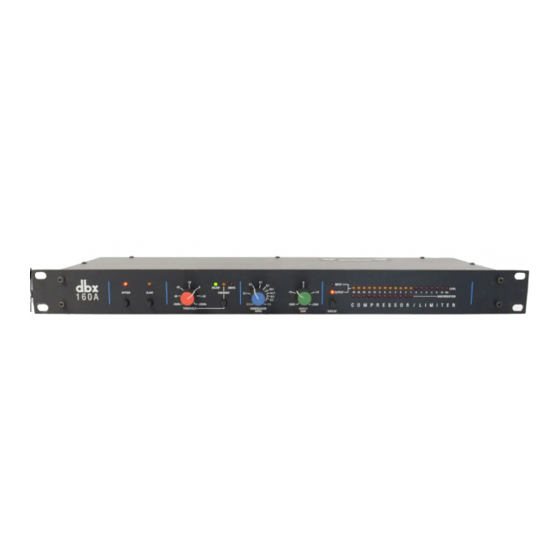dbx 160A Manuale di istruzioni - Pagina 12
Sfoglia online o scarica il pdf Manuale di istruzioni per Apparecchiature musicali dbx 160A. dbx 160A 20. Compressor limiter
Anche per dbx 160A: Opuscolo e specifiche (2 pagine)

dbx 160A COMPRESSOR / LIMITER
As a general rule, compressors should be as close to the amplifiers as possible in the signal chain. If the 160A is placed
before the EQ (equalizer), for example, a potentially damaging boost in the EQ won't be seen by the 160A and the speakers
may be damaged. (see Multi-way speaker systems, page 9.) For maximum sound pressure levels, large sound reinforce-
ment systems frequently use a separate compressor on each output of the electronic crossover(s). For a stereo sound-rein-
forcement system, stereo strapping cables should be run between the 160As in each band (low-low, mid-mid, etc.).
Raising Average Level in PA Systems
Limiting (i.e., compression at high ratios like ∞:1) also benefits intelligibility by allowing low-level input signals to be
reproduced through the system at higher volume. In a musical performance, this provides additional intimacy as the vocal-
ist's whispers are heard clearly at every seat in the house. The OverEasy curve available with the 160A permits a very high
amount of compression (COMPRESSION RATIO of 10:1 or greater) to be used in many situations. This allows dynamic
speakers, vocalists and other musicians to concentrate on their presentation or performance without worrying about the ill
effects of volume changes.
Using Your EQ to Reduce Feedback in Live Settings (Indoor and Outdoor Concerts, Churches)
You can use your 160A and EQ (equalizer) to reduce feedback in clubs, churches, outdoor concerts and other live settings.
Patch or insert the 160A into the main output of a mixer, set the 160A to Hard Knee mode and slowly increase GAIN
CONTROL until the first feedback "ring" occurs, then set up the 160A with its COMPRESSION RATIO at ∞:1 and
THRESHOLD low. The 160A will catch the first feedback ring and hold it as a constant tone so you can adjust your EQ to
minimize it. Continue to increase your console gain and set your EQ until the next 3 or 4 "ring" frequencies have been
compensated for .
The 160A as a Line Amplifier
To use the 160A as a line amplifier, adjust the COMPRESSION RATIO control fully counterclockwise (1:1 position),
THRESHOLD fully clockwise (+20) and OUTPUT GAIN to whatever setting is required for the application. Remember,
excessive gain may lead to output clipping of high level signals. To add compression, adjust the COMPRESSION RATIO
and the THRESHOLD controls to the desired settings.
Frequency-Weighted Compression (Sidechain Application)
It is possible to separate certain vocals and instruments from a mix by frequency-weighted compression. With an equalizer
(such as a dbx 20 or 30 Series EQ) inserted ahead of the DETECTOR INPUT (but not in the audio path), the equalization
settings do not shift the timbre or frequency response of the audio signal . They merely alter the threshold response of the
compressor on a "frequency-weighted" basis.
With this arrangement, raising certain frequencies on the equalizer causes them to be suppressed in the audio signal. A rela-
tively high THRESHOLD setting can allow normal sounds to be unaffected while solo and very loud sounds are com-
pressed. (Of course, when compression occurs, the level of the entire program is affected.) Depending on the
THRESHOLD setting, lower level fundamentals or harmonics will not cause compression, and the program is not subject
to the phase shift normally caused by program equalization.
When recording cymbals and tom-toms, a compressor with an equalizer in the detector path can help prevent tape satura-
tion. The equalizer can be adjusted for boost with a peak of about 5kHz, causing the cymbal to be compressed on a very
loud crash, stopping tape saturation at high frequencies, where there is less headroom. However, gentle tapping of a drum-
stick or brushing of the cymbal will not be affected. Assuming the tom-tom is a lower frequency instrument and can be
better tolerated by the tape, it has less need for compression. Equalization in the detector circuit means that the compressor
is not triggered as readily by a loud tom-tom beat as by an equally loud cymbal crash.
Figure 4: Frequency-Weighted Compression
8
